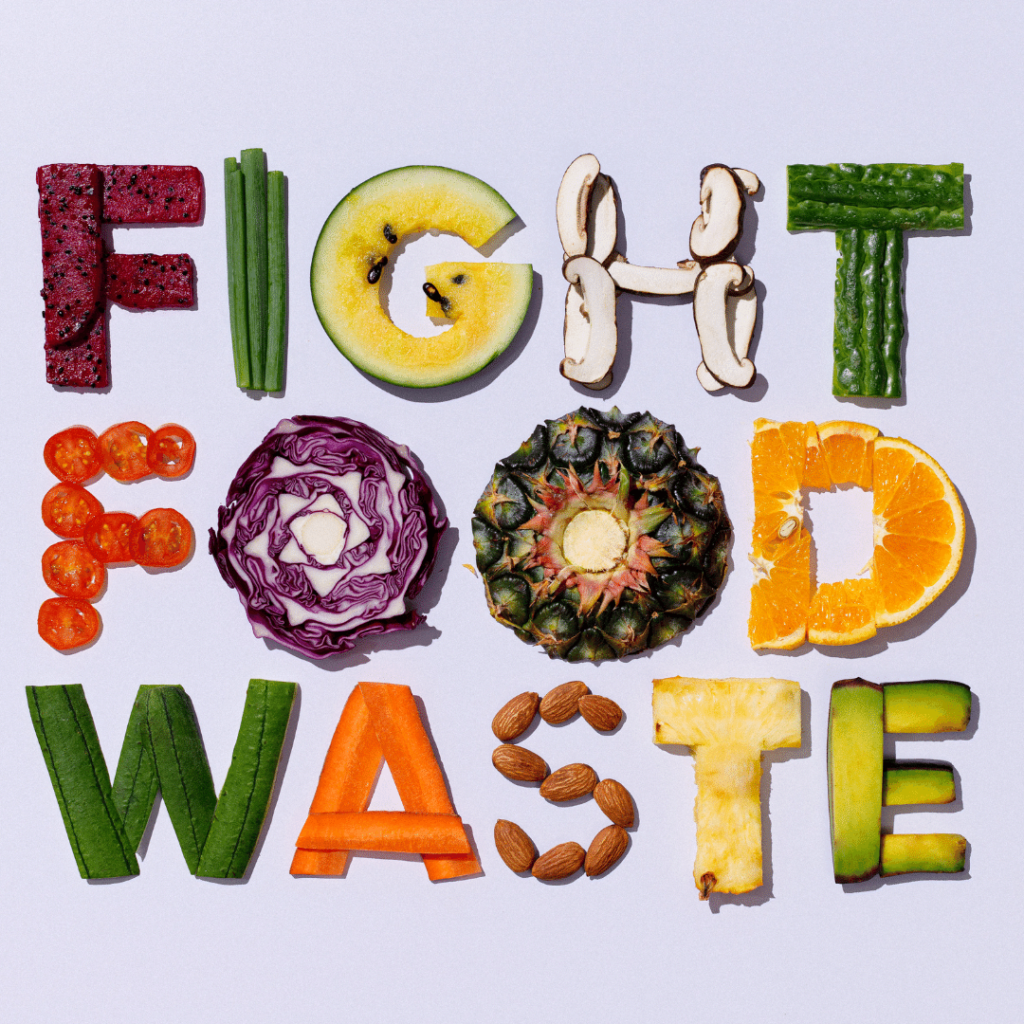Fighting Food Waste

Imagine there was a simple way to save your time and money and eat more nutritiously. It sounds almost too good to be true . . . but it isn’t. If there’s one thing that impacts our schedules, wallets, and health, it’s food.
Curious as to why I am talking about food waste?
Well, a substantial amount of highly nutritious food, such as fresh fruits and vegetables, gets discarded. It is beneficial for your health to consume these nutritious foods before they spoil. Nonetheless, reducing food waste does not mean you have to eat every last bit of food you purchase or prepare. Overeating is not the healthiest approach, and there are more effective ways to reduce food waste, which we will discuss here.
Cutting down on food waste not only saves you time and money but also enhances environmental sustainability and fosters relationships within your community. It’s truly a win-win-win situation! If you have ever tossed a container of yogurt nearing its expiration date, thrown away wilted vegetables, or discarded a slightly browned salad, you are not alone. While food waste is a global issue, the United States is a major contributor. Shockingly, food occupies more space in U.S. landfills than any other type of waste.
Regrettably, nearly 40 percent of the entire U.S. food supply is wasted, amounting to almost 20 pounds of food per person each month. Just imagine the time and money you could save by implementing some of the helpful tips I provide below. Discussing and sharing solutions to food waste is crucial because there are numerous unhelpful (and unhealthy) notions out there. I am eager to share some of the most effective solutions with you.
Benefits of reducing food waste
The impact of food waste is wide-ranging.
The less food we waste, the more time and money we can save—and these are so very important right now that we are in a time of supply chain interruptions, food prices are high, and people in the world are going without. If there was ever a time to be mindful of food waste, NOW is the time.
By reducing the amount of food wasted, farmers can use less fresh water, land, fertilizers, etc., because they’re not producing food that’s going to be discarded. Reducing food waste also reduces the amount of food that needs to be processed, transported, and stored (sometimes in unrecyclable packaging and energy-intensive refrigerators and freezers).
Plus, with less food waste, less space is used in landfills and less greenhouse gas is produced. Not to mention that there are a few not-as-obvious societal impacts that I’m going to [discuss/talk about/show you] as well.
Let’s dive a bit deeper into each of these benefits of reducing food waste.
Save time
Leftovers may not be the most glamorous meals, but they allow you to cook (and clean up) once and eat twice. This uses your precious time more efficiently because you’re not making a huge effort to decide what new meal or snack to make (or buy) and then spending even more time preparing or heading to the store or restaurant. [Plus, if you’re like me, spending less energy on multiple new meals every day means less stress.]
Save money
You probably don’t want to spend your hard-earned cash on something you’re not going to use—even when it comes to buying food. The amount of produce wasted by an average American family of four costs about $1,600 per year. Imagine what you could do with that amount of money by simply buying only what you need and are going to eat without unnecessary excess.
Save the environment
Reducing food waste helps us use critical resources like our land, water, fertilizers, packaging, transportation, storage, etc., much more efficiently. That’s because these investments will go toward food that we’re going to use and enjoy, not producing excess that’s going to be discarded. These efficiencies can help to reduce our environmental impact.
Throwing food away wastes not only the water and energy that went into all of the steps needed to get the food to you, but when it’s in a landfill, food waste releases greenhouse gases like carbon dioxide and methane. The U.S. Environmental Protection Agency (EPA) estimates that 95 percent of discarded food ends up in landfills instead of the compost.
Boost your relationships and community
When you share extra food with people you know and care about, you’re building relationships with them. Plus, there are plenty of people who may need to use community services to access food. By sharing food with them, you can help increase food security in your community.
Tips to reduce your household food waste
Now that you know some of the benefits of reducing food waste at home, here’s how to make it happen.
It’s true that food is wasted at every level, from farm to fork. Farms, manufacturers, grocery stores, and restaurants all waste some of their food. While you may not be able to control these other areas, reducing your own food waste can make a significant difference. That’s because household food waste accounts for the biggest amount of food wasted (at 43 percent—more than restaurants, grocery stores, and food service companies combined).
1 – Freeze food and enjoy your leftovers
Sometimes we buy or make too much food to eat in one day. As a dietitian, I don’t want you to try to force yourself to eat more than you need in order to reduce your food waste. Instead, store uneaten food in a sealed container in your fridge or freezer, and then enjoy it another time.
REAL LIFE TIP: If you are not going to eat it tomorrow, just put it in the freezer immediately. Do not bother shoving it into your refrigerator, where it makes its way to the back and is forgotten about, only to be thrown out. Yes, we have all done this…..
Safety First: Be sure to pack up and safely store leftovers within 1-2 hours. Do not leave it out at room temperature.
Leftovers can also save you time and money when you’re super-busy because you can quickly take a meal out of the fridge or freezer instead of spending the time and money to prepare or buy a whole new meal.
2 – Know your dates
One of the biggest reasons people throw away food is because they think it’s spoiled. This is understandable because no one wants to eat or serve food that has gone bad and may make them sick. Sometimes, the date that food goes bad is not always clear because manufacturers may use different dates on their packages. In an effort to reduce confusion, the U.S. FDA is recommending the use of:
- “Best if used by” to describe the quality of the food (not its safety); the food may not taste or perform as expected, but it’s still safe to consume as long as it was stored properly.
- “Expires on” is mostly reserved for infant formulas which should not be used beyond that date.
3 – Try “imperfect” or “ugly” food
Did you know that food is sometimes dumped because it doesn’t look “perfect” enough? Looking for “imperfect” or “ugly” food, or food that’s approaching its “Best if used by” date, is another way to save money and reduce food waste.
Some markets and grocery stores package up food that may be “ugly” or not as fresh as their latest shipment and sell them at lower prices than the “perfect” food we’re used to seeing. Many of these imperfect foods can still be used in smoothies, soups, and baking.
Pro tip: Check to make sure the imperfect foods are still safely edible and are not spoiled; then, prioritize freezing or eating these foods first.
By choosing “imperfect” or “ugly” foods when you’re out shopping, you can help prevent it from going to waste while saving money at the same time.
4 – Share extra food
If you know someone who would love to join you for a meal or appreciate your leftovers afterward, consider sharing with them. You can invite them over or drop your extra food off to them.
Another idea is to find a food bank or shelter in your area and see what types of food they accept. If you have extras of those, simply donate it to them. [If you want to go the extra mile, you can even consider donating the amount of money you saved from reducing food waste to your local food bank or shelter so they can purchase what is most urgently needed.]
5 – Optimize your fridge and freezer
Don’t forget to regularly check your fridge and freezer to keep an eye on any food that may be approaching the end of its useful life. If you find any, enjoy them first.
Pro tip: Keep your fridge set to a maximum temperature of 40°F and your freezer to 0°F or lower to keep your food fresh as long as possible.
6 – Compost [and use organic collection programs] whenever you can
The U.S. EPA estimates that just 4.1 percent of wasted food is composted, so composting is a huge area of opportunity. If you have a backyard and the ability to compost food scraps to make nutrient-rich soil, that is a great place to start. Alternatively, if your city, town, or region has a composting program, you can contribute to that instead of putting food waste into the garbage, which goes to the landfill.
7 – Use a grocery list and meal plan
When you plan out the meals you want to eat and stick to your grocery list, you’re less likely to purchase and make too much food. If you create a thoughtful grocery list—and stick to it—you can buy only what you need and will reasonably eat each day or week.
How meal planning can help reduce food waste
Having a plan for your meals—whether you make the plan yourself or invest in one that works for you—is a great way to reduce your food waste. That’s because when your meals are planned out, you can create a grocery list of the foods you need for that plan. If you double-check your pantry, fridge, and freezer before adding something to your grocery list, and stick to the list when you’re out shopping, you will buy only what you need and are planning to eat.
By using a meal plan to reduce the amount of excess food you buy in the first place, you’re cutting down on food waste at the source. This is called “source reduction.” According to the U.S. EPA, source reduction is the most impactful step toward reducing food waste, so it’s a great one to focus your efforts on.
Meal planning has other benefits beyond reducing food waste and saving you time and money. Using meal plans can help you create meaningful and sustainable changes for your health. For example, a recent study published in the Annals of Behavioral Medicine looked at people who joined a weight loss program. They found that participants who planned more of their meals lost more weight than those who planned fewer meals.
Final thoughts
By reducing food waste, we can help to save time and money, reduce our impact on the environment and even build our relationships and communities. It truly is a win-win-win situation.
One of the best ways to get started tackling this problem is by using a meal plan. Meal plans can inform your grocery list and then reduce the amount of extra food purchased list when you go shopping at the market or grocery store. But, not everyone wants to spend the time and effort to create their own plans. If this is you, I would love to help with your meal plans!
In Health and Happiness,
Felicia
